#HYDE IS A PERSONA HE USES TO HURT PEOPLE AND DO BAD THINGS!!!! WHY DO YOU THINK HIS NAME IS HYDE!!!!!
Explore tagged Tumblr posts
Text
"my character is based on Jekyll and Hyde!"

"they switch personalities and do evil things and have no memory afterward!"

#ness.txt#aka stop demonizing signs of dissociative disorders and systems and actually do research on the book you hooligans#Jekyll remembers all of his actions as Hyde and everybody misunderstands the book like!! oh my god!!!!#PLEASE research the book if you plan this i know pop culture has fucked up on it time and tine again but#im so SO tired#ask to tag#ableism#ableism /#i KNOW i sound like some preachy English major who thinks theyre better than everybody#but im tired of people demonizing systems and alters using 'inspired by Jekyll and Hyde' to excuse it#when that book is completely misconstrued by pop culture and most of the public!!!#Jekyll isnt inherently a 'good' man and wants to hurt others!! constantly and actively!!! and he does by utilizing Hyde!!!!#HYDE IS A PERSONA HE USES TO HURT PEOPLE AND DO BAD THINGS!!!! WHY DO YOU THINK HIS NAME IS HYDE!!!!!#HES HIDING HIS IDENTITY#also im a HUGE literature nerd and this book means a lot to me and idk why it does
7 notes
·
View notes
Text
Repress Your Feelings, Girl.
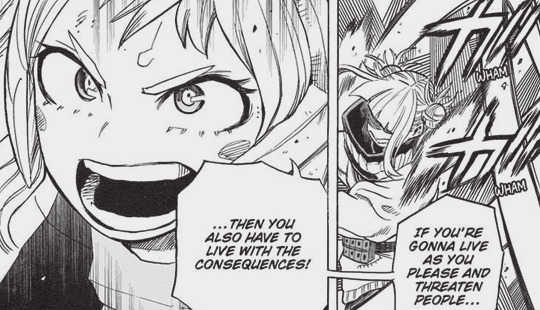
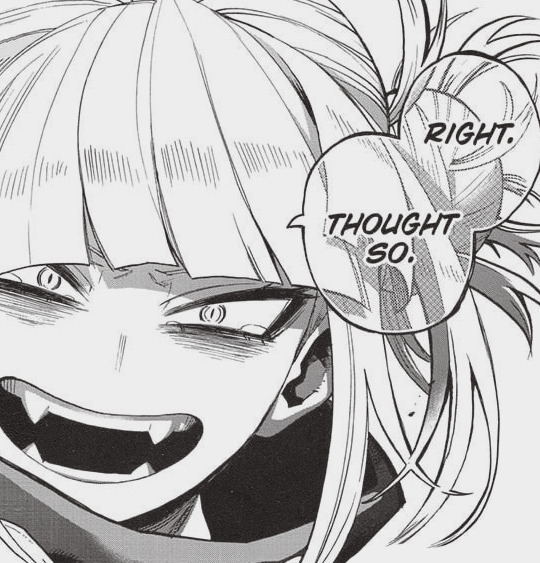
Toga and Uraraka can’t understand each other: because Toga can’t explain herself properly, and Uraraka doesn’t really want to understand. However, there’s also a narrative reason behind why these two characters are fighting each other. It has nothing to do with morality, good or bad, hero or villain, but rather the writing of the characters themselves. Toga Himiko and Uraraka are foils, two sides of the same coin meant to reflect each other. They are essentially (in narrative terms at least) the same person, just both of them expressing different sides of themselves. Uraraka Ochako represses, and Himiko Toga expresses herself, more on their foiling underneath the cut.
Before I start out I just wanted to point out a few of the deliberate paralels the narrative draws between the two characters. First, the girls come from completely opposite circumstances.

Uraraka comes from a poor family, whereas Toga comes from what seems to be a wealthy household, considering there’a a gate in front of their door.

Typically Himiko would be the privileged one, but the narrative inverts this. Uraraka grows up in a household where her identity is affirmed by her parents no matter what. Himiko grows up in a household where she is constantly told she is wrong by her parents.


Ochako is continually accepted for who she is, and Toga is told not to be herself, not only suffering parental abuse, but also psychiatric abuse on top of that.
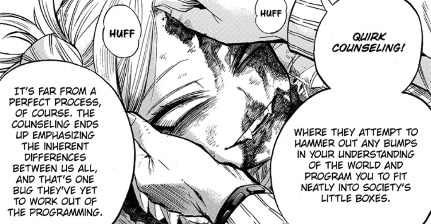
One more way in which they are opposites, Ochako is someone who tends to be sheltered (her parents did her best to hide the fact they were suffering from her because she didn’t want her to feel guitly about it, however it produced the opposite effect, Uraraka got better at reading the faces of people and noticing their suffering.)
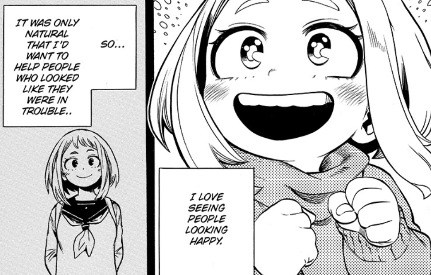
Himiko on the other hand has grown up very unsheltered, she’s been on her own since middle school. There’s several hints she’s been exposed to the ugliest side of people already and spends her life running away from them and keeping herself safe from them.

Himiko and Uraraka are both incredibly good at reading other people, but they developed this ability for opposite reasons. Uraraka who was sheltered noticed the pain her parents tried to hide from her and developed it compassionately, and Himiko who has been on the run for most of her life developed it as a method of survival. However, that doesn’t mean that Himiko is lacking compassion, or Uraraka always empathizes with everyone she meets, because both of them are complex individuals.
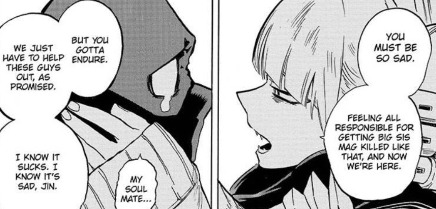
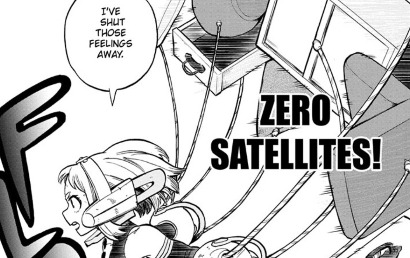
Himiko is capable of empathizing with other people, not only that but she’s grown significantly out of her shell and learned that other people besides her have needs, feelings she needs to take care of, to the point where she’s stopped prioritizing herself first in all circumstances. On the other hand, Uraraka is just as capable of shutting her feelings down and ignoring the viewpoints of other people she finds disagreeable with her own.

Uraraka and Toga are also both extremely social people, however all of Uraraka’s friends accept her for who she is. Deku knows Uraraka so well that he can tell when Toga, pretending to be Camie, is the one replacing her. Toga is someone who like Uraraka was always at the center of a group of friends tying her together. However, Toga could only present her fake self in front of them.
1. The Repressed

Jung divides the self into three, the shadow, the persona, and then the ego (self) which is made of a combination of the former too.
Persona
The persona is how we present ourselves to the world. The word "persona" is derived from a Latin word that literally means "mask." It is not a literal mask, however.
The persona represents all of the different social masks that we wear among various groups and situations. It acts to shield the ego from negative images. According to Jung, the persona may appear in dreams and take different forms. [source]
Shadow
The shadow is an archetype that consists of the sex and life instincts. The shadow exists as part of the unconscious mind and is composed of repressed ideas, weaknesses, desires, instincts, and shortcomings.
The shadow forms out of our attempts to adapt to cultural norms and expectations. It is this archetype that contains all of the things that are unacceptable not only to society, but also to one's own personal morals and values. [source]
My Hero Academia uses Jungian Symbolism, especially in regards to Himiko and Uraraka’s characters, this isn’t something I made up it’s directly in the text. Toga’s act of repression is literally called: wearing a mask.

Toga and Uraraka are written to contrast each other on which part of themselves they present to the world. Uraraka is extremely conscious of other people’s expectations of her, so she plays up her persona. Uraraka is someone who is always putting up a show for others because she knows how they perceive her.
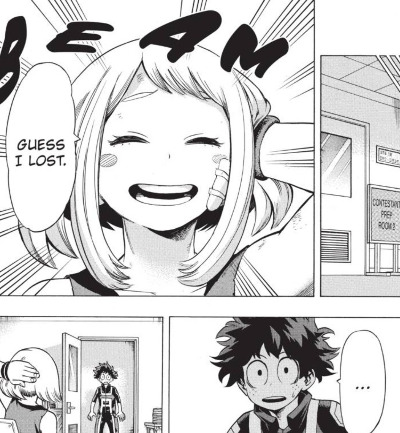
Her own perceptiveness works against her, because while she loves seeing people happy the most she also can’t stand to see them in pain, or even be the reason why they’re in pain. Uraraka’s solution to this is a rather immature one, she believes if she’s good all the time, if she’s always this pleasant and happy person and never shares her problems then she won’t drag the mood down.
Uraraka is conflict avoidant in other words. There are times she directly addresses the conflict like the times with Tsuyu, but even then it’s in a “We should all get along as friends” sort of way. Uraraka always pushes her feelings down and tries her hardest never to cause trouble for others. However there’s a line between trying not to hurt others, and simply pretending the conflict does not exist.
The shadow is the part of ourselves we repress in order to play for other’s expectations. The persona is a performance, it’s the personality you perform every day. You would swear with a group of friends, but you wouldn’t swear in front of your grandparents. People hide parts of themselves depending on who they’re interacting with, personality is in part a performance to the expectations of others around you, that’s natural. Everyone will have a side of themselves they show to others, and a side of themselves they keep repressed. That’s natural. What is not natural is to be all one way or all the other.
‘Man is not truly one, but truly two’ “Dr. Jekyll and Mr. Hyde.”
The point of the shadow and the persona, is that both are true at the same time. You are both who you pretend to be, and what you hide of yourself. The persona is not fake just because it’s a performance, and the shadow isn’t the true self or all there is to you just because it’s hidden. However, the opposite is true at the same time, the persona is not all of who you are, and you can’t make your shadow go away just by repressing it.
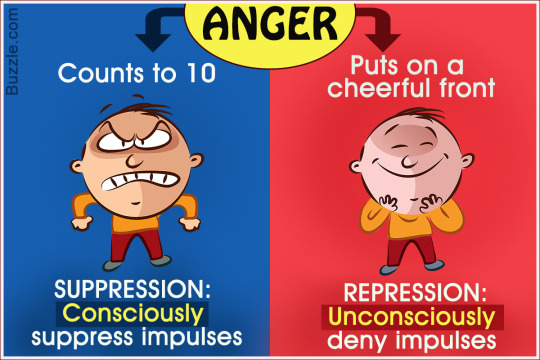
Psychological repression is not a healthy strategy for dealing with emotions. It doesn’t resolve emotions, it just makes them go away for a short time. One response to the presence of a shadow is to simply ignore it, but ignoring it will just make you ignorant.

Uraraka views herself to be a good person, and views heroes to be good, but that belief hasn’t come from confronting the bad of society and deciding that heroes are still good anyway. Which is my point, not that Uraraka is wrong, but that she’s ignorant. She’s sheltered, naive, and her lived experience is so narrow she can’t realy make a judgement call on Toga that’s accurate. Like, just for exmaple heroes do in fact kill people. They even get excited about completely destroying villains.
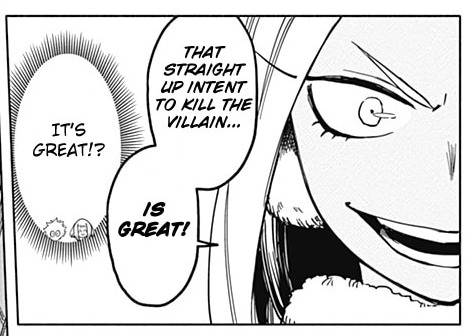

There are heroes who become heroes just to beat the shit out of villains, there are heroes who will try to kill villains, Tokoyami gets confronted with the fact that Hawks killed a villain and his first response is: You did nothing wrong, Hawks. Uraraka sees heroes as the ideal only ever saving people. Yes heroes save people. There are other heroes who are violent. It’s not one or the other, the truth requires acknowledging both at once. Uraraka’s point that she would never feel happy about violence is a false one, because she doesn’t know that for one, and two heroes are just as capable of violence as villains.
The key point to repression is that it doesn’t work.

Himiko already tried reperssing herself and it just drove her insane. The feelings don’t go away simply by pretending that they are not there. Even in a narrative sense, Uraraka’s shadow that she has repressed has escaped her in the form of Himiko and is running around constantly trying to challenge her and confront her to get her to acknowledge those feelings. The feelings will not go away, and Uraraka’s solution is to just keep putting a lid on them and pretending they are not there. It’s because she has such a tight lid on herself it makes her impossible to see things from Himiko’s point of view.
Why is Uraraka supposed to understand things from Himiko’s point of view? Because Himiko is Uraraka, she’s all of her repressed flaws come to roost. Uraraka cannot change or improve as a person until she accepts both the best and worst of herself instead of just trying to always be good all the time. Understanding Himiko leads to a more gray and nuanced understanding of reality rather than the black and white: heroes good, villains bad. Himiko is a foil, a narrative device used to show the flaws of another character.
Uraraka did nothing wrong / Uraraka is right.
Well okay then, but Uraraka would be a pretty boring character otherwise. She’d just be a good girl who did good things all the time and always tried her hardest. I’m not trying to insinuate Uraraka is a bad person, I’m arguing in favor of her complexity. I think there is more to her character than just her trying to be a better hero, and getting stronger and learning to use her powers better. There’s an emotional complexity to Uraraka that she represses.
Emotionally, Uraraka is similiar to Himiko because they both cope poorly in the same way. Emotional repression is unhealthy. Himiko has only two modes, repress everything or don’t repress anything and both of those extremes are bad. Uraraka is on the path to becoming Himiko, because the only way she knows how to deal with things is to shut her feelings off and as Himiko said that doesn’t work: it just drove Himiko insane.
2. The Expressed
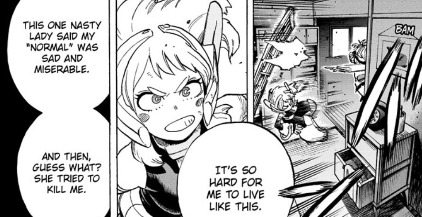
Himiko Toga is who she is in reaction to her trauma. Uraraka pushes herself down and tries to play to the expectations of others, and Toga asserts herself and tries to defy other people’s expectations.
I’m actually going to blow everybody’s minds here though: Toga doesn’t actually want to murder people and suck their blood dry. It’s what she thinks she wants, but once again, she is who she is, in reaction to trauma. Toga was violently abused, Toga became violent, but it’s not who she is inherently. It’s who she thinks she is.


Toga has internalize every bad thing every person has ever said about her. Toga not only foils Uraraka, she also foils Shigaraki. Toga has been convinced, that what she wants naturally, is to suck people’s blood, and kill them. The same way that Shigaraki has been convinced by AFO that he was naturally born with the urge to destroy others.

These aren’t things that they have a natural inclination or desire to do, it was things they were told about themselves repeatedly. Shigaraki by AFO, and Toga by everyone around her. Even Toga’s initial incident of violence has a lot more in common with a psychotic break, then with you know, a pre-meditated murder that she did for pleasure.
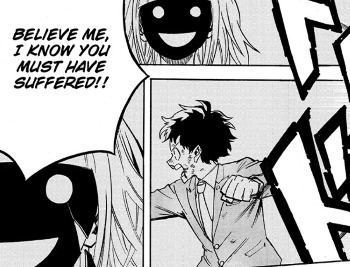
It’s not something Toga naturally did on her own, it was something she was pushed to do. Remember, Toga suffered twofold abuse. Abuse from her parents, but also psychiatric abuse. The people who were supposed to help her reconcile her quirk, and her unnatural tendencies didn’t try to heal her like they were supposed to. She was demonized by everyone around her, told what a bad girl she was constantly, not for anything she did wrong but because she was born naturally with a quirk. She tried to be good and smile for the sake of others, untils he reached a breaking point: then and only then did she lash out.
Toga’s initial instant of violent wasn’t a pleasure killing. It was a lashing out due to a psychotic break, and it was because both of the systems in her life that were supposed to help teach her to learn to deal with emotions, quirk counselling this world’s version of child therapists, and her own parents, chose to demonize her and tell her to repress herself.
However, children who are abused tend to internalize the words their abusers tell them. Children who are abused often believe they “deserve” their abuse because of their bad behavior.
Now, I’m not trying to justify. I don’t think Toga Himiko is allowed to run around killing whoever she wants just because she was abused. My intent is to explain how her brain works.
Toga Himiko doesn’t get to lash out as she pleased, but I think it’s important to understand that Toga’s lashing out is what makes her human. She’s not an inhuman monster, she’s a human reacting to circumstances. Most people exposed to ugly situations, react in ugly ways, and the few that don’t are the exception that proves the rule.
My point being that Toga is not an insane monster that lusts for blood, she just believes herself to be one. The same way that Uraraka is wrong, Toga is also wrong at the same time.
Because as I said the above is right. Toga can’t live her life just lashing out. While it’s understandable, someone who has endured violence can’t keep lashing out violently forever. Toga’s choice to always lash out is just as unhealthy as Uraraka’s choice to always repress herself.
Because Toga relies again and again on violence to vent her feelings, violence has become an inescapable part of her life. It’s also contrary to what she really wants. Toga thinks she wants violence, but the violence is just a reaction to the violent abuse.
Yes, Toga says all she wants is to drain people dry of their blood but characters are liars sometimes.
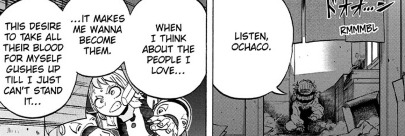
Sometimes you can’t take a character at their word. Sometimes instead of reading something directly as stated line for line in the story you have to read between the lines. Toga says she wants to just kill people, but her internal thoughts contradict her.
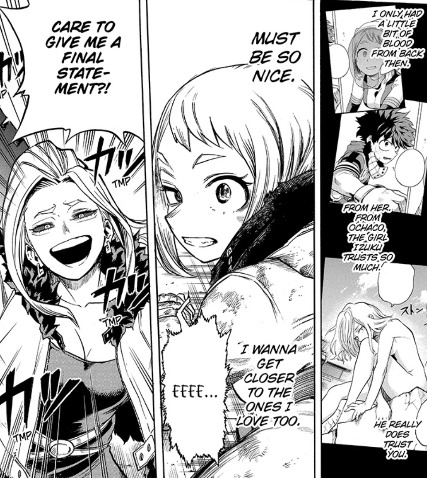
What Toga needs is to be accepted, loved, and trusted like Uraraka is. That’s her deep internal desire that she states to herself when pushed to her absolute edge by Curious. What Toga thinks she wants is to drain the people she wants dry of their blood, so she can become them and live vicariously through them. What she thinks she wants is a life where she can do whatever she wants, and do as she pleases, in response to a life where she wasn’t allowed to do anything that she wanted. But, that again is a child’s idea of rebellion. It’s a response to her abuse, it’s not who she is. However, Toga’s personal development was forwarded not by killing people and draining them, but by the empathy and acceptance she showed towards Jin.
There’s what she needs, what helps her develop into a more stable person, the empathy and care she shows to Jin. The acceptance Jin showed her in return.
There’s what she thinks she wants, which is to just rebel against everything and always do what she wants in every single situation and accept no limitations on her personal desires.
Toga is in fact just a normal girl, who wants to be accepted by the society at large, or at least find people who accept her. However, Toga doesn’t see herself as one, because she’s internalzied the idea that she’s the blood thirsty monster that everyone thinks she is. Which is why Toga contradicts herself.
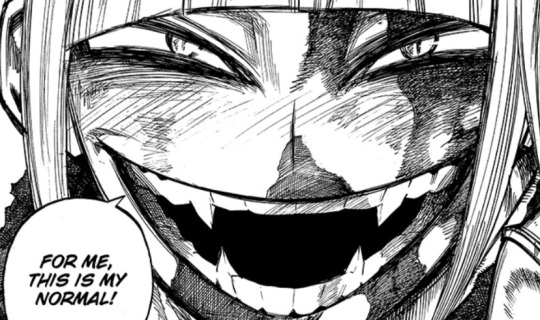

Toga in the same breath will say��“I’m also a normal girl” and then “I’m a weird kid, I’m a weirdo, no one can understand me.”
Toga cannot explain herself, because she’s wrong about herself. She’s making herself out to be a violent monster because that’s how she copes, the really really bad way she copes. It’s easier to be a violent monster, she’s more protected that way, then to be a runaway girl who’s just scared and alone. However, because Himiko can’t admit this, she also can’t explain herself to other people. She presents the monstrous version of herself and that’s all Uraraka can see.
Neither Uraraka nor Himiko’s way of coping is sustainable. Uraraka cannot keep repressing herself forever, the same way Himiko cannot violently lash out forever.

While what Uraraka says is very black and white, it’s not wrong. If HImiko is goign to live her life “Kill or Be Killed”, then she’s just as likely to end up being killed then she is to be the killer. There’s no happy ending to that kind of life.
However, there is no happy ending to Uraraka’s way of living either. Her perfectionist tendencies and her desire to only ever be good just aren’t going to work, because one a lot of bad things are going on already Uraraka just doesn’t see them, and two it’s not sustainable, Himiko was someone who held everything in too and look where that got her.
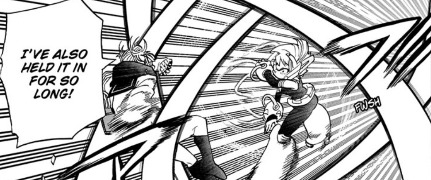
Uraraka and Himiko’s talk failed because neither of them are capable of communicating right now. Uraraka can’t understand because she doesn’t try, and Himiko can’t explain herself because she also doesn’t try.
Uraraka only sees what’s good about the world, about heroes. Himiko only sees what’s bad about the world, about heroes. Uraraka sees the beautiful parts, Himiko embodies the ugliness.
However they are both wrong because they are both short sighted. People are not just their shadows, and they’re not just their personas. They are both at the same time.
A junagian shadow confrontation doesn’t end in a fight between good or evil. The shadow is not evil, the persona is not good. They are just two halves of the same person. Defeating a shadow does not make it go away. The shadow is something you have to learn to live with, the same way everybody on earth is flawed, and just tries to live every day working on their flaws the best they can.
The shadow is something that has to be reconciled. Uraraka and Toga don’t have to defeat each other, they have to reconcile with one another.
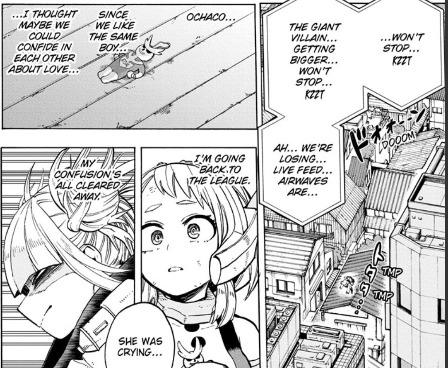
The narrative is pushing their reconciliaton because Toga and Uraraka both have what the other needs to grow. Uraraka is ignorant because she’s lacking experience. She hasn’t lived Toga’s experiences so she doesn’t understand her perspective. She doesn’t know, and she won’t know until someone explains it to her. However, saving as many people as possible means that Uraraka should also be open to trying to save people who react to abuse in ugly ways as well, because a person can be a victim and a villain at the same time. Uraraka will be a better hero if she’s able to see the flaws in her own society, because she’s a part of the next generation to reform society.
And Toga can’t become someone who is trusted by others if she’s violently lashing out all the time. The same way that Uraraka needs to see what’s bad about the world, Toga needs to learn to see what’s good about the world. The same way Uraraka needs to see both sides of the world, that of a villain girl and that of a normal girl. Toga needs to come to terms with herself, that she’s not a violent monster, but a normal girl. The only way she can stop lashing out and start actually taking responsibility for what she’s done and start on the path to self improvement is if she starts seeing herself as a person capable of improving.
Toga wasn’t born this way she was made this way. She’s just a people, and people change. Toga can either try to change, or keep lashing out forever but at the moment she doesn’t even know that changing is an option for her. She thinks she’s going to be stuck as a monster forever because she was just born one. That’s why, Toga also needs Uraraka as much as Uraraka needs her.
#togachako#uraraka ochako#ochako uraraka#himiko toga#toga himiko#lov meta#mha meta#league of villains meta#my hero academia meta#league of villains#toga himiko is a terrible person#yeah but she's fascinating#besides it's not like she killed YOUR MOM#she hasn't hurt anybody in reality#she's a character in a narrative and we can analyze her without the need to moralize her#because obviously killing is bad#but like beyond that it's constructive to look at her and try to understand her as a person
317 notes
·
View notes
Text
Queer Eye for the Cap Guy ~ Part 6
A/N: Hello my darling lovelies! So as you all know I’ve been on hiatus. I am still sort of on hiatus. I don’t really know what will come when, but things are settling so I’m hoping to share more with you in the near future. But for now. The long awaited (at least on my end) Karamo section his here. This took a really long time, because I didn’t feel like I was doing Steve’s character justice, and I hope that I did.
Also thanks a million to @supermusicallee for listening to me rant my way through every incarnation of this scene.
Summary: Karamo talks to Steve about his self-image. Who really knows Steve Rogers
Rating: T
Warnings; Angst, honestly this one is heavy. It deals with Steve’s feelings of inadequacy both before and after the serum. Mentions character deaths and survivor’s guilt. It ends I hope in an uplifting way, but Steve’s got baggage and this is me trying to unpack it
Word Count: 2389

Steve and Jonathan were chatting casually when Karamo arrived.
“Oh. My. God. You look amazing.”
“Jonathan does great work,” Steve replied, deflecting the compliment but couldn’t hide his smile.
“I mean I do,” Jonathan agreed, “But it’s not just that.”
Karamo seemed stunned by the change in Steve.
“You are glowing. How do you feel?”
“I feel great. Honestly. I like what I see when I look in the mirror,” he added softly.
Karamo and Jonathan beamed at him.
“Awesome. Awesome. Well are you ready to spend some time with me?”
“Yes, sir.”
“Alright then, let’s go.”
Steve hugged Jonathan one more time and followed Karamo out to the truck.
“So a little birdie told me that you always dreamed about taking art classes at the Brooklyn Academy of the Arts.”
“Once upon a time, yeah.”
“Well, we’re going to check out a class today.”
“Really?” Steve couldn’t help but smile.
“Yes, sir. And here we are.”
“Welcome, class. Today we’re working on our shadow perspective. And then we’ll work on our self-portraits.”
Steve was all smiles as they taught about how to use shadows in your art to add depth, and enhance human features. But that faded somewhat when they started working on the self-portraits.
The crease in his brow deepened with each swipe of charcoal on the canvas. Still, the completed piece was beautiful.
“You are very talented, Captain Rogers.”
Steve’s cheeks reddened with the praise at the instructor’s comment.
“Thank you. And thank you for the lesson, it was enlightening.”
“Thank you so much. Do you mind if we hang out in here for a while?” Karamo asked as he shook hands.
“Take as much time as you like,” she offered before exiting the room.
Both men sat back down in front of their easels, Steve adding a few more details to his sketch.
“Thank you for bringing me here.”
“You’re welcome. But I didn’t just bring you here for art lessons. I wanted to really get a chance to talk to you.”
Steve nodded. He’d been expecting this. And he’d been dreading it.
“You mentioned at the beginning of the week that you wanted to find a future, and I want to help you do that. But we can’t talk about your future until we talk about your past and your present. Now I didn’t just pick this class for you to learn some techniques. So let’s take a look at how you see yourself. What’s going on in this?”
He gestured to the sketch of Steve in his uniform and helmet holding his shield. It was incredibly detailed down to char marks on the shield and the texturing on the suit. But his face was hidden by the helmet.
“It’s me.”
“I want you to tell me what about this sketch is you. Because I just see Captain America. Where does Steve Rogers show up? ”
Steve let out a sad laugh.
“He’s in there. They’re pretty much the same person.”
“You weren’t always Captain America.”
“Don’t think that skinny kid from Brooklyn was all that interesting,” Steve scoffed.
“And what about the man that you are now? He’s not Captain America.”
“He’s not all that interesting either. People don’t care about the man behind the cowl.”
Steve smudged his finger along the charcoal lines of his jaw, softening it slightly.
“Do you care about the man behind the cowl?”
“I-,” Steve clamped his mouth shut as the question seemed to rattle into his bones.
“Since you got the serum have you ever defined yourself as something outside of Captain America?”
“I mean I left the shield behind when everything happened with Tony. I wasn’t Captain America then.”
“But were you Steve Rogers or were you just not Captain America?” Karamo gestured firmly with his hands.
“I guess the second one. But I didn’t really think about it. We were all so focused on not getting caught, and maybe actually still managing to do some good. Though that was questionable.”
Leaning forward in his seat Karamo studied Steve’s facial expressions.
“Did you want to be Captain America again?”
“After I was pardoned you mean?”
“Before or after. I’m just curious if that was what you were fighting for.”
Steve was silent again, observing his own sketch.
“I guess so. I mean at this point it feels like all I’ve ever known.”
“But is it what you want?”
“I want to help people. I can do that as Captain America.”
“Is that the only way you can do that though?”
“Feels like it sometimes. I went into the ice, one hundred percent certain that that was the end. I chose. And I’d make the choice again. My life against thousands, no question. I was at peace with that decision when I went into the ice. And then I woke up. Seventy years in the future.”
His voice was tight as he spoke, eyes shining with unshed tears.
“And suddenly Captain America is a legend, something bigger than I could have ever dreamed. I saw what he meant to people, and I thought it was a good way to get back into the world. To do good in the world. I’m not quite sure I ever deserved the mantle at least in its current incarnation, but once I had it I couldn’t separate myself from it. Until it all came crashing down and I had to choose. I couldn’t pretend the man that I was and the persona of the perfect soldier were the same person. They never really were.”
“And the man that you are? Who is he?”
“Just a guy from Brooklyn. He used to be a hero. But he’s not all that important anymore.”
Karamo held his hand up.
“I’m going to stop you. You, Steve Rogers, are important to a lot of people. Not as Captain America, as you. I had the opportunity to talk to some of your teammates on Tuesday. Do you know what they talked about?”
“Not a clue.”
“Well, they didn’t talk about missions or press conferences. They told me how you make their lives better by being you. Natasha told me about the family dinners you organized. And the time you and Bucky spent the afternoon winning stuffed animals for little kids and Coney Island. Y/n talked about how you sneak her chocolate when she’s in the med bay and that you’ll re-watch her favorite Disney movies just to make her smile. And Sam told me about you learning how to lead support groups for returning vets. You mean everything to those people. And you’ve touched so many other lives, your other teammates, those kids, those veterans. You mean something to every single one of them. The only person who thinks for even a second that Steve Rogers doesn’t matter, is you. Can you tell me why that is?”
“Because I don’t deserve it. Captain America has saved people. All I’ve ever done is get people killed,” he spoke clearly, confidently, and Karamo could see that Steve believed that down to his very bones.
“So you’re telling me that every time you failed that was you, but every time you won it was Captain America?”
Steve nodded.
“That’s not how it works. Captain America and Steve Rogers aren’t Dr. Jekyll and Mr. Hyde. All of your bad isn’t in one and your good in the other.”
“Maybe not. But Captain America is a national treasure. Steve Rogers is a footnote in his history. I am a footnote in his history.”
Tears which Steve had managed to keep at bay finally broke through the dam, wetting his cheeks. Karamo reached out to comfort him with a firm hand on his shoulder.
“Before the serum, I was nothing but a burden. My Ma raised me all on her own, and I couldn’t do a damn thing to help her. I was so sick. Every time I got a job I’d get hit by some sort of illness. She was taking care of me and everyone else around her until the day she died. Bucky was the only one who didn’t see me as something to wipe off their shoes before they came in the house, but even then he was trying to take care of me, pulling me out of alleys or dragging me to his house so he knew I’d eaten.”
Steve quieted for a moment, taking a deep breath before continuing.
“Even when he’d left for the army he was trying to look out for me, he’d wanted me to stay with his mom and his little sister, but I met Dr. Erskine that night. I was never really of any use to anybody. And then I got this body and the first thing I did was let the man who’d believed in me die. And in no time flat I led Bucky to the same fate. Actually a worse fate, given what he went through. I’ve got blood on my hands that nearly a century in the ice couldn’t wash away. Nothing could ever wash it away. But that’s not in the history books now is it?”
Angry sobs racked the super soldier, and his head fell to Karamo’s shoulder. The culture expert simply held him as he cried.
“There’s always been a part of me that was relieved to lean in to the façade when I came out of the ice. I could chalk most things up to waking up in a new century. It didn’t take long to figure out what people expected and after that it was easy to act accordingly. I chose to leave Steve Rogers behind because I couldn’t face what I’d done. I think I thought I was honoring those I’d gotten killed in a way, by being a hero and pushing aside the pain. I was Captain America and that’s who they died for after all. But when I came face to face with Bucky on that bridge, that wall crumbled and every ounce of guilt I’ve ever felt consumed me. I couldn’t push the man down anymore, and then more people got hurt because I wasn’t being Captain America. I don’t regret what I did with Bucky and the Accords but I regret that so many people were hurt on my watch. I’m not sure how to live with that. I feel like tarnished the one good thing I had brought to the world. The shield.”
“You are such a good person, Steve, and you have brought so many good things to the world. People believe in you not in the shield. Yes, there are always consequences for our actions and there are things that we have to own. But there is a line between taking responsibility and blaming yourself. You did not let anybody die. You didn’t choose that. Terrible things happened, but just because you weren’t able to prevent them doesn’t mean you let them happen,” Karamo assured him.
“I should have been able to stop it,” Steve argued half-heartedly, his breath was still ragged.
“I know the serum gave you super strength and probably a lot of other things we don’t know about, but it didn’t make you perfect.”
“That I know,” he murmured humorlessly.
“Would you say that you tried to be superhuman after the serum?”
He was already shaking his head.
“I just wanted to be good enough.”
“It is good enough to be exactly who you are. That’s not to say that you can’t improve. But you are human. We succeed and we fail. And we grow from it. The thing about symbols is that they are whatever people want them to be. You need to be what you want to be. And that doesn’t mean good enough. And it doesn’t mean Captain America. It means Steve through and through. Come with me.”
Steve reluctantly followed him to the large mirror. It was cloudy and streaked with specks of paint but he was still faced with his reflection.
“Tell me who you see.”
It was a long time before he spoke. Steve had been looking in mirrors all week. And he hadn’t been lying when he told Tan and Jonathan that he liked what he saw, but he hadn’t realized just how little he felt like it was him he was looking back at.
“Is he Captain America?” Karamo pressed.
“No,” he shook his head. “But he’s not that skinny kid from Brooklyn either.”
Steve stared hard, looking for himself in what he saw, and finally he saw it. The set of his jaw as he focused on the task at hand. It had never changed, no matter how big he got.
“He’s me. But a new version. Someone I don’t quite know yet.”
‘Who do you want to be?”
“I want to be someone who’s not afraid to let people in. I want to be close to people, to let them see who I really am.”
“Good. Good. And you know what? You have already taken the first step. You let me and the other guys in. You have been so open with us and I hope that you can continue that with your friends.”
“I do too. Thank you.”
“You’re welcome. Now, there’s one more thing I need you to do.”
“What?”
“I want you to look in the mirror and tell yourself ‘I am enough.’. Go on.”
“I’m enough,” Steve mumbled, not looking at his reflection.
“No, eyes on you.”
“I am enough,” he murmured a little louder this time.
“Scream it.”
“I AM ENOUGH!”
He yelled to get Karamo off his back, but Steve’s voice carried through the halls of the building and echoed back to him. Through him. And for the first time he believed it.
“I am enough,” he whispered softly in acceptance. Karamo Interview
“Steve has spent so much time separating himself from his public identity that he’s completely forgotten who he is. And it doesn’t seem like he wanted to know. He has convinced himself that the people around him are only there because he’s Captain America, but that is so not true. They love him for who he is, but he had to love himself for who he is. And he’s on his way to do that, as he lets go of the pain and the guilt and just be Steve for the first time in maybe ever.
~~~~~~~~
A/N: I hope that you enjoyed and that I did this justice. Thank you so much for reading! I’m planning two more parts probably but the last part will be very long I think so it may be broken out. I don’t have timeline but once I know what’s going on I’ll let you know. I’ve missed you all my darlings. Hope all is well.
Tag lists are open
Queer Eye for the Cap Guy Tag List @a-random-queer-kid @mimisparkle12 @phoenix-whiskey-tears @taliarosej00 @cs-please
Steve/Chris Tag List @isaxhorror @peachykeen3502 @patzammit @wordlesscaptain @coffeebooksandfandom @hereisanapplepie @mywinterwolf @straightforwardly
Marvel Tag List @hdthdthdt @sophiatomlinson23 @misty-panther @supermusicallee @scarlettsoldier @acupofhotlatte @slender--spirit @petitesmate @libbymouse
Permanent Tag List @iamwarrenspeace @jayzayy @bexboo616 @neoqueen306 @santheweird @rowenaravencalw @buckitybarnes @prxttybirdz @sergeantjbuckybarnes @captainsamwlsn @broitsmydick @ailynalonso15 @nyxveracity @queenoftrash97 @walkingtravesty97 @lamia-maizat @memyselfandmaddox @lowkeybuckyb @whiskey2011 @averyrogers83 @lovingpeterparker @buckybarneshairpullingkink @beansparker @coralphantomninja @xxashy999xx @thisismysecrethappyplace @ravennightingaleandavatempus @paintballkid711 @whosmarisaaarw @silverkitten547 @yknott81 @mmmmmmmmmchicken @thefridgeismybestie @crispy-kitten @isabelcrichards @greyeyedsmile14 @loving-life-my-way
53 notes
·
View notes
Text
“There is one school of thought which believes that the gruesome images portrayed in popular culture influence young people to imitate what they see. There is another view that young people need exposure to darker concepts in books and films so that they can more clearly evaluate what is important and real in life” What is your opinion?
In the 21st Century of easy accessibility, youth today are very easily exposed to images, concepts, and ideas of darker topics such as death, evil, superstitions etc. Literature of the gothic or horror type being one of the most influential sources of these concepts i.e. The Strange Case of Dr Jekyll and Mr Hyde by Robert Louis Stevenson and Coraline by Neil Gaiman. Some people believe that even though exposure to this material may have negative effects on children and adolescents, within a controlled environment, these effects can be easily avoided. Exposure to darker topics may even help youth to better understand the social workings of our world, what is real in the world and the correct behaviour to display within society.
Often children and some adolescents need to be encouraged to be able to see the difference in what is real and what is not in this world. Gothic literature often tells of different versions of reality, however, novels such as Coraline by Neil Gaiman use the subjects of reality and imagination separately. Particularly through the mind and world of a child. In the novel, it depicts how two worlds who hold essentially the same objects and people function in extremely different ways and how this affects a young child as she categorises either world into ‘fun’ or ‘boring rather than ‘safe’ or ‘dangerous’. A lesson that is often taught to children and adolescents.
In the beginning of the novel, Gaiman often emphasises the positives of Coraline’s ‘dream world’ as she receives everything she desired desperately for in her reality from her ‘other family’. However, quick to follow is the negatives of the ‘dream world’ as Gaiman defines the major difference between the two worlds; that one is only a distorted reflection of the other. He describes Coraline’s ‘dream world’ to “...twist and copy and distort things that already existed.” and a “...parody of the real people and real things…” This description suggests a deceit, danger, and artificiality to this world and its inhabitants. As if to say that everything pulls you back to the real world.
Exposure to Coraline on this particular topic allows children and adolescents to learn to differentiate, for themselves, between reality and imagination. In cases wherein the child or adolescent is unaware and unable to do this, adulthood may bring with it issues such as dissociation and disappointment with their reality as it does not hold within it, things that do not exist.
Furthermore, it can be said that children and adolescents are more likely to learn how not to behave when exposed to films or books that may portray darker concepts. Responsible adult supervision is a helpful factor, in which they can help to explain why criminal acts have negative consequences and why it is morally wrong. In the novella, The Strange Case of Dr Jekyll and Mr Hyde by Robert Louis Stevenson, there are scenes in which violence and death take place; “Hyde broke out of all bounds and clubbed him to the earth…with ape-like fury, he was trampling his victim under foot…” and there are also mentions of substance abuse as Jekyll continues to transform into Hyde. However, if the text is properly comprehended, a young reader will be able to understand and identify the consequences that come with these actions; how it affected Jekyll/Hyde himself and those around him. Stevenson made it clear that Hyde’s acts of violence were horrendous and morally wrong as he describes Hyde’s first act of violence; “…it was hellish to see. It wasn't like a man; it was like some damned Juggernaut.” As for the substance abuse, it is revealed that Jekyll’s death was caused by an overdose of his substance but even before that, it was clear to see that Jekyll’s health and social life was slowly deteriorating. The quotes “…he found this return of solitude to weigh upon his spirits.” and “…there lay the body of a man sorely contorted and still twitching.” describe Jekyll/Hyde’s final moments of suffering, both mentally and physically. This should serve as an example for children and adolescence as to what not to do as the consequences that come after criminal acts can be particularly serious and should not be treated otherwise.
Exposure of darker topics to children and adolescents assist in educating them on how the world and our society does not only consist of ‘rainbows and cupcakes’. That there is evil and a darkness that can be difficult to comprehend, working in our society and culture on a daily basis. In Jekyll and Hyde, the story depicts how good and evil work within a single person, the last chapter - Dr Jekyll’s explanation of the events - stating “I saw that, of the two natures that contended in the field of my consciousness, even if I could rightly be said to be either, it was only because I was radically both…”.
The novel Coraline also deals with the duality of good and bad in a single person. The Other Mother first giving off the impression of a fun-filled, loving and caring mother whose world revolves around Coraline as she states;“It wasn't the same here without you. But we knew you'd arrive one day, and then we could be a proper family.” Later on in the novel, the Other Mother’s persona seems to give off quite the opposite feeling; “She will take your life and all you are and all you care'st for, and she will leave you with nothing but mist and fog.”
In any circumstance, it is simply human nature in which we as people have two sides; a good side and a bad side. It is important that children and adolescents are aware of this in order for them to be able to differentiate and identify between good and bad within themselves and other people and being able to balance the two. This will also prevent a naivety and innocence that could bring negative aspects through their adolescence and adulthood. Such as being easily manipulated or convinced as a result of not being able to identify when someone behaves in a way that they intend to hurt themselves and/or others. In Jekyll and Hyde as the character Mr. Utterson is unaware and unable to identify that his single friend was both identities of Jekyll and Hyde as he states how the two may be connected but are not the same person; “This Master Hyde, if he were studied…must have secrets of his own; black secrets…secrets compared to which poor Jekyll's worst would be like sunshine.”
The novel Coraline is particularly helpful in identifying the difference between good and evil and Coraline herself begins to realise the dangers in which the Other Mother intends to put her in. Coraline also begins to fully comprehend what she means to the Other Mother; “...the other mother loved her. But she loved Coraline as a miser loves money, or a dragon loves its gold.”
To conclude, exposure of darker topics such as death, evil and superstitions are a vital part of a young, growing mind as it assists with their maturity development, social interactions, behaviours and knowledge. This is evident through the stated arguments that gothic literature that is easily accessible to youth today can very easily be turned into positive influences. Influences that teach valuable lessons about ourselves, other people and the world itself. Materials such as The Strange Case of Dr Jekyll and Mr Hyde, a novella by Robert Louis Stevenson and Coraline, a novel by Neil Gaiman are examples of good sources in which hold the concepts and ideas of darker topics that can be used to educate the younger generation.
2 notes
·
View notes